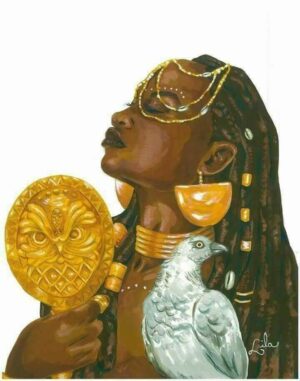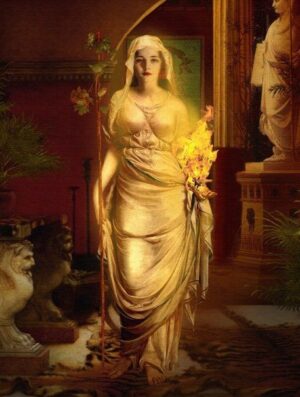Are you looking to learn about or work with a specific goddess of beauty? Today we’re covering 13+ goddesses of beauty from different cultures and the archetypes they represent.
Welcome to a captivating journey through the mythological realm of goddesses of beauty! In this exploration, we’ll delve into the diverse cultures and ancient tales that celebrate the essence of beauty in its many forms. From radiant goddesses who embody physical allure to those who nurture inner grace and strength, each deity we encounter adds a unique facet to the concept of beauty.
In these narratives, beauty isn’t just about appearances—it’s a reflection of the profound connections between nature, emotions, and the human experience. We’ll uncover goddesses who inspire love, creativity, and the appreciation of life’s pleasures.
Let’s set sail on this wondrous odyssey and discover the captivating world of goddesses of beauty!
13. Aphrodite: The Greek Goddess of Beauty and Love

Kicking off our global tour is the ever-charming Aphrodite, the Greek goddess of beauty and love. Imagine strolling on the sun-kissed shores of ancient Greece, where tales of Aphrodite’s bewitching allure spread like wildfire.
Aphrodite is often portrayed as the epitome of physical beauty and grace. She is described as having an unmatched radiance, with golden hair that cascades down her shoulders like sunlight. Her ethereal presence captivates all who behold her, and her enchanting smile is said to have the power to spark desire in the hearts of both gods and mortals.
The shell is one of the most iconic symbols associated with Aphrodite. Legend has it that she was born from the sea foam, and she was carried ashore on a scallop shell. This shell is not only a representation of her origin but also a symbol of her connection to the sea’s timeless beauty. Doves are sacred to Aphrodite and symbolize her role as the goddess of love and harmony. Doves are often depicted alongside her, emphasizing her ability to bring people together and foster feelings of affection and unity.
While Aphrodite is celebrated for her physical beauty, her essence goes deeper, representing the beauty of human connections, emotions, and desires. She embodies the transformative power of love, inspiring acts of compassion, tenderness, and selflessness.
Aphrodite’s myths often explore the complexities of love and desire, showcasing her influence over gods and mortals alike. Her stories remind us that beauty is not only about appearances, but also about the emotions and connections that make life meaningful.
12. Hathor: The Divine Muse of Joy and Beauty

Imagine the sweeping deserts of ancient Egypt, where the golden rays of the sun illuminate the grand temples dedicated to Hathor. Often depicted as a cow or a woman with cow’s horns and a sun disk, Hathor is celebrated as the embodiment of feminine charm, beauty, and joy. Her name translates to “House of Horus,” signifying her role as the nurturing mother of Horus, the falcon-headed sky god.
One of Hathor’s most enchanting attributes is her association with music, dance, and artistic expression. She is often depicted playing musical instruments like the sistrum, a type of percussion instrument, and is considered the patroness of musicians, singers, and dancers. Hathor’s divine melodies and rhythmic movements are believed to bring harmony and joy to both mortal and immortal realms.
Hathor’s influence extends beyond her role as a symbol of physical beauty. She is also revered as a goddess of love, fertility, and motherhood. Her nurturing and protective qualities are often depicted as a loving mother who embraces and cares for both the living and the deceased. In this aspect, Hathor exemplifies the depth of beauty that transcends the surface and extends to the bonds of family and community.
Hathor’s mythology is replete with stories of transformation, reflecting the ever-changing nature of beauty and life itself. In some tales, she is known as the “Eye of Ra,” a fierce and protective deity who can bring forth both healing and destruction. This duality highlights the multifaceted nature of beauty—sometimes gentle and nurturing, other times powerful and transformative.
11. Inanna: The Mesopotamian Queen of Heaven

In the heart of ancient Mesopotamia, the radiant figure of Inanna reigns supreme. Known as the Queen of Heaven and Earth, Inanna embodies a complex blend of qualities, making her a fascinating goddess to explore.
Inanna’s beauty is often likened to the brilliance of the morning star, so her symbolism with Venus makes sense as a goddess of beauty. She is depicted as a radiant goddess, adorned in luxurious garments and jewelry, symbolizing not only physical beauty but also the splendor of the heavens.
Inanna’s allure goes beyond her external appearance; it encompasses her captivating charisma and the aura of confidence she exudes.
One of the most intriguing aspects of Inanna’s mythology is her descent into the Underworld. This journey is a profound symbol of transformation, shedding light on the depths of human experience. Stripped of her divine regalia and powers, Inanna navigates through trials and challenges, ultimately emerging transformed and renewed. Her story reminds us that true beauty is born from the crucible of life’s trials, and it is our ability to rise above challenges that truly defines us.
Inanna’s character is marked by dualities—she is both a loving nurturer and a fierce warrior. She embodies the dichotomy of life itself, encompassing birth and death, love and war, beauty and power. Inanna teaches us that embracing these dual aspects within ourselves leads to a richer, more authentic expression of beauty.
Inanna’s legacy empowers us to embrace the full spectrum of our existence. Her story teaches us that beauty is not a static concept but a dynamic force that evolves through our experiences and choices. Just as Inanna emerged from the Underworld stronger and wiser, we too can harness the challenges we face to become more resilient and beautiful in our own unique ways.
10. Lakshmi: The Radiant Hindu Goddess of Wealth and Beauty

In the tapestry of Hindu mythology, Lakshmi shines as a luminous figure, embodying both outer beauty and inner richness. Often depicted as a graceful woman adorned in resplendent attire and jewels, Lakshmi’s physical beauty is a reflection of her divine essence and her role as the bestower of wealth and prosperity.
Lakshmi’s association with beauty goes beyond the material realm. She symbolizes not only the wealth of material possessions but also the wealth of spiritual qualities such as wisdom, compassion, and devotion. Her presence in Hindu homes and temples is a reminder of the importance of cultivating both material and spiritual abundance.
One of the most iconic images associated with Lakshmi is her emergence from a lotus flower. The lotus, which rises from muddy waters to blossom in pristine beauty, symbolizes purity, growth, and spiritual enlightenment. Lakshmi’s connection to the lotus reinforces the idea that true beauty arises from the depths of our experiences, and through inner growth, we can manifest our full radiance.
Lakshmi’s role extends beyond material wealth to encompass love, harmony, and unity. She is often depicted with four hands, each representing different aspects of her essence. In one hand, she holds a lotus, symbolizing purity and beauty. In another, she holds gold coins, representing wealth. The remaining hands are raised in a gesture of blessings and protection. This multifaceted depiction emphasizes her capacity to bring beauty and harmony into all aspects of life.
While Lakshmi’s physical beauty is celebrated, her true significance lies in her ability to guide individuals toward inner beauty and spiritual fulfillment. She reminds us that true beauty goes beyond appearances and encompasses qualities such as kindness, generosity, and selflessness. Lakshmi’s blessings encourage us to seek beauty not only in our external surroundings but also in the way we interact with the world and nurture our inner selves.
9. Clíodhna: The Graceful Sea Goddess

In the misty landscapes of ancient Ireland, Clíodhna stands as a luminous presence, captivating all who encounter her with her ethereal beauty. She is often described as a stunning woman with long, flowing hair that shimmers like the moonlight on the sea. Clíodhna’s allure goes beyond her physical appearance; it encompasses an aura of grace and charm that leaves a lasting impression.
Clíodhna’s mythology often revolves around themes of love and desire. She is renowned for her romantic adventures, which are steeped in passion and emotion. One of the most famous tales involving Clíodhna tells of her love for a mortal man named Ciabhán. Their love story reflects the depth of human emotions, from the heights of joy and connection to the depths of longing and separation.
Clíodhna’s association with the sea adds another layer of enchantment to her persona. Just as the sea’s beauty is both tranquil and unpredictable, so too is Clíodhna’s influence. She is believed to be a guardian of the waters, watching over sailors and guiding them safely on their journeys. Her connection to the sea reinforces her role as a goddess who embodies the captivating mysteries of nature.
While Clíodhna is celebrated for her physical beauty, her true essence lies in the emotional depth she represents. Her myths delve into the complexities of human relationships, reflecting the highs and lows of love, desire, and the human experience. Clíodhna’s stories remind us that beauty is not just a surface-level concept but a reflection of our emotions, connections, and vulnerabilities.
8. Bastet: The Feline Elegance of Ancient Egypt

In the pantheon of Egyptian deities, Bastet shines as a graceful figure, often depicted with the head of a lioness or a domestic cat. Her feline features evoke a sense of elegance and mystery, and her dual nature represents both the nurturing aspects of a domestic cat and the fierce protective qualities of a lioness.
Bastet’s image is one of timeless allure and aesthetic grace. Her depictions show her as a radiant goddess, often wearing an ornate collar and sometimes adorned with jewelry. Her connection to the feline world highlights her affinity with agility, poise, and a certain enigmatic charm that captivates all who encounter her.
Beyond her physical beauty, Bastet embodies the qualities of a caring and protective guardian. She is often invoked for her ability to safeguard households and to bring about a sense of security. Her nurturing side, reminiscent of a domestic cat’s gentle presence, underscores the idea that true beauty extends beyond appearances and is rooted in the emotions and connections we share.
7. Freya: The Norse Enchantress of Love and War

In the realms of Norse mythology, Freya stands as a luminous figure, embodying both the allure of physical beauty and the depth of emotional connections. Often depicted as a radiant and enchanting woman, Freya’s beauty is said to rival the brilliance of the sun. Her charm and magnetism capture the hearts of gods and mortals alike.
Freya’s physical beauty is a source of fascination and admiration, often described as golden-haired and radiant. Her presence is captivating, and her charm is said to be irresistible. In Norse tales, Freya’s beauty is not only a reflection of her appearance but also a symbol of her inner strength and charisma.
Freya’s role extends beyond physical beauty to encompass the realms of love, fertility, and passion. She is often associated with matters of the heart and is considered a patroness of romantic relationships. Her influence is felt in the depths of human emotions, reminding us that beauty is intertwined with the intensity of desire and connection.
What sets Freya apart is not only her physical beauty but also her inner strength and autonomy. She is a goddess who commands her own destiny, unafraid to pursue her desires and make her own choices. Freya’s independence and self-assuredness serve as a reminder that true beauty is not passive but a force that empowers us to shape our lives.
Learn more about working with Freya here.
6. Oshun: The Yoruba Goddess of Beauty and Sensuality

In the vibrant tapestry of Yoruba mythology, Oshun shines as a luminous figure, embodying the radiant essence of beauty, sensuality, and emotional depth. Often depicted as a stunning woman adorned in vibrant yellow or gold, Oshun’s beauty transcends the physical and touches the very heart of human experience.
Oshun’s physical beauty is captivating, with her radiant appearance symbolizing her connection to the sun’s warm glow. Her form exudes a sense of grace and charm that lights up the world around her. Oshun’s allure extends beyond her appearance; it encompasses an aura of sensuality and vibrancy that awakens the senses.
Oshun is often depicted holding a mirror and a comb, symbols of self-reflection and self-care. These objects emphasize her connection to self-appreciation and the importance of nurturing one’s inner and outer beauty.
Oshun’s role extends beyond physical beauty to encompass the realms of love, sensuality, and creativity. She is often invoked for matters of the heart, fertility, and artistic inspiration. Her influence is felt in the intensity of emotions and the celebration of the human experience in all its forms.
What sets Oshun apart is her deep emotional connection to humanity. She is believed to be a compassionate and caring goddess, ready to listen and offer guidance to those in need. Oshun’s nurturing nature underscores the idea that true beauty extends beyond appearances and resides in the genuine care and love we show for ourselves and others.
5. Amaterasu: The Luminous Sun Goddess of Japan

Amaterasu shines as a luminous figure in Japan, embodying the brilliance of the sun and the beauty it bestows upon the world. Often depicted as a radiant woman with a celestial glow, Amaterasu’s beauty is synonymous with the dazzling splendor of sunlight.
Amaterasu’s physical appearance is described as resplendent and enchanting, mirroring the ethereal qualities of the sun’s glow. Her form radiates a celestial light that symbolizes not only physical beauty but also the spiritual illumination she brings to the world.
The sun disc is a common symbol associated with Amaterasu. It represents the sun’s radiant energy and Amaterasu’s role as the bringer of light, life, and beauty to the cosmos. However, the mirror is another significant symbol linked to Amaterasu. It reflects her dual nature as both a physical being and a divine presence, highlighting the concept of self-reflection and inner beauty.
Amaterasu’s role extends beyond her physical beauty to encompass the realms of light, blessings, and cosmic harmony. She is considered a benevolent deity who bestows her divine radiance upon the world, bringing forth life, growth, and abundance.
Amaterasu’s mythology also carries a symbolic message of inner illumination and spiritual awakening. In one tale, she retreats into a cave, shrouding the world in darkness. It is through the efforts of other deities that she emerges, bringing light back to the world. This narrative underscores the cyclical nature of life and the importance of finding inner light even in times of darkness.
4. Mazu: The Empowering Sea Goddess of China

Mazu stands as a luminous figure in Chinese mythology, embodying both the enchanting allure of the sea and the compassion that guides those who traverse its waters. Often depicted as a serene and graceful woman, Mazu’s beauty mirrors the tranquil elegance of the ocean’s depths.
Mazu’s physical form exudes a sense of calm and serenity, mirroring the soothing nature of the sea. Her presence is often depicted as gentle and reassuring, symbolizing her role as a protector and guide for those in need.
The lotus blossom is a common symbol associated with Mazu, representing purity and spiritual growth. Just as the lotus rises from the depths of the water to bloom in radiant beauty, Mazu’s influence guides individuals to rise above challenges and find their own inner radiance.
Mazu’s role extends beyond her connection to the sea; she is revered as a compassionate deity who watches over those who sail its waters. She is often invoked for protection, guidance, and safe journeys. Mazu’s influence highlights the importance of empathy, care, and the profound impact one’s actions can have on the lives of others.
While Mazu is celebrated for her serene appearance, her true beauty is rooted in her compassionate nature and the inner wisdom she embodies. Her stories emphasize the importance of inner strength, resilience, and the ability to navigate life’s challenges with grace and poise.
3. Venus: The Roman Goddess of Love and Beauty

In the pantheon of Roman deities, Venus shines as a luminous figure, embodying the essence of beauty, love, and desire. Often depicted as a graceful and alluring woman, Venus’s physical beauty is both captivating and evocative of the passions that her presence stirs.
Venus is often thought of as synonymous with Aphrodite, yet there are some differences between Greek and Roman culture. In Rome, we see her become more like a mother, and she has much more to do with day-to-day life (such as finances) rather than simply affairs.
Venus’s role extends beyond physical beauty to encompass the realms of romantic love and desire. She is often invoked to inspire passion, attraction, and affection between individuals. Venus’s influence emphasizes the transformative power of love and its ability to bring joy and fulfillment into the lives of mortals.
While Venus embodies physical beauty, her true significance lies in the emotional depth she represents. Her myths often explore the complexities of human relationships, highlighting the joys and challenges of romantic connections. Venus’s stories remind us that beauty is not solely about appearances; it is about the emotions and connections that make life meaningful.
2. Ixchel: The Maya Moon Goddess of Renewal

Journeying into the heart of ancient Mesoamerica, we encounter Ixchel, the radiant moon goddess of the Maya civilization. Associated with fertility, healing, and the cycles of nature, Ixchel’s beauty is closely intertwined with the ever-changing phases of the moon. She teaches us that beauty, much like the moon’s glow, waxes and wanes, but its essence remains constant and eternal.
Ixchel’s role extends beyond her connection to beauty; she is revered as a goddess of healing, fertility, and creation. She is often invoked to bring about wellness, both physical and emotional. Ixchel’s influence emphasizes the interconnectedness of beauty, health, and the cycles of life.
While Ixchel is celebrated for her physical beauty, her true significance lies in her nurturing and creative nature. Her stories often emphasize the importance of tending to one’s own well-being and cultivating inner beauty through acts of compassion, creativity, and self-care.
1. Vesta: The Eternal Flame of Inner Beauty

Our final destination brings us to the hearth of ancient Rome, where Vesta, the goddess of the hearth and home, shines her gentle light. Vesta’s beauty is not one of outward adornment, but a representation of the inner flame that sustains and nurtures. As the eternal fire keeper, Vesta symbolizes the beauty that radiates from a steadfast and nurturing heart, illuminating the lives of those around her.
Although not typically associated with physical beauty in the same way as other goddesses, Vesta’s role encompasses a different form of beauty: the beauty of domestic order, sacred rituals, and inner tranquility.
Vesta’s presence is often depicted as a dignified and serene figure tending to the sacred fire. Her beauty lies not in external appearance but in the purity and sanctity she brings to the home and hearth. Vesta’s quiet strength and unwavering commitment to maintaining the sacred flame are reflective of the beauty that comes from within—a beauty that radiates from a heart that is at peace.
Vesta’s role extends beyond the physical boundaries of the home; she represents the idea of creating a harmonious and sacred space within ourselves. She reminds us of the importance of nurturing our inner world and finding beauty in simplicity, order, and the rituals that bring a sense of peace and tranquility.
As we reach the end of our journey through the fascinating tapestry of goddesses of beauty names, we find ourselves immersed in a symphony of cultures, myths, and radiant figures. From Aphrodite to Ixchel, Freya to Mazu, each goddess we’ve encountered adds a unique hue to the ever-evolving spectrum of beauty.
These goddesses are more than just symbols of physical allure; they are embodiments of the qualities that make life a masterpiece. Through their stories, we’ve discovered that beauty is not confined to the surface but extends to the depths of our emotions, our connections, and our inner strength.
Just as these goddess of beauty names grace the mythologies of the world, may they also inspire us to see and celebrate the beauty within ourselves and in every facet of existence. In the embrace of their legacies, may we find the courage to nurture our own inner radiance, to explore the beauty in diversity, and to weave our own stories of love, compassion, and creativity.


